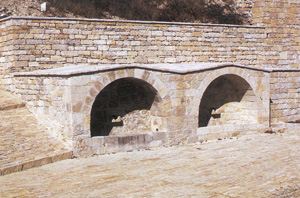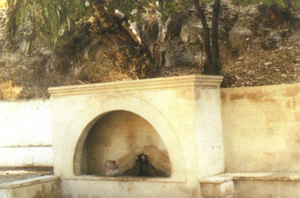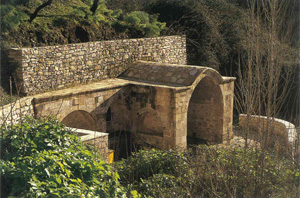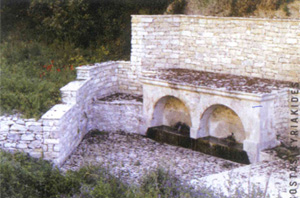Cascading down the slopes of the mountain Laona (1,092m), Arsos, with its 250 inhabitants of today, is situated 40km from Limassol and 45km from Paphos; and falls within the jurisdiction of the municipality of Limassol, although essentially it belongs to the Metropolis of Paphos.
The name Arsos is derived from the word ‘ALSOS’, which means ‘small forest’ and according to one train of thought, Arsos was once a holy place dedicated to the goddess Aphrodite. Another belief has it that Ptolemy Philadelfos built four cities in Cyprus with the name Arsinoe, which he dedicated to his sister and wife, one of these cities being Arsos.
Arsos, one of the wine village of Limassol, has 40% of its area planted with vines. The village has two wineries; Nikolettivo and Laona, as well as a spring water factory also named Laona.
As mentioned before, tradition has it that Arsos was once a small forest and the inhabitants of the surrounding area claimed that in the depth of the forest they could see a shining light, which led them to find the ruins of an old church. Upon further excavations they discovered the holy relics of the Apostle Philip. The church was rebuilt (in the 13th century) in the central square of the village, which was appropriately named Apostle Philippos Square. On the north side of the main church which is stone built, without dome, one finds the remains of the ancient church dedicated to St. Mariamnis (sister of Ap. Philip) and although it was originally used as a confession room, it has since been transformed into an icon storeroom. The church steeple was built in 1912 and together with the church itself has been declared a B Class ancient monument.
The church and central square were restored in April 2012. The village celebrates the feast day of Ap. Philip on the 14th November.West of the village and next to the cemetery, lies the church of the Holy Mother Catholiki Chryseleousa which was recently restored in 2012. The village is know for its stone paved roads.
Along the banks of the river Diarizo from Athkios until Trozena, there are many plantations with all sorts of fruit trees.
Plentiful water flows all year round from the 6 medieval fountains found west the village. A nature path has been created which connects all the 6 fountains; the visitor following this patch which will come across vegetation particular to the area as well as freshwater crabs and frogs.
VRISSI OSS’ARKATSIN (Oss’Arkatsin)
Next to the spring, one can find the byzantine monastery of the Holy Mother, Catholiki. One of the springs is holy water of the Holy Virgin. During wedding processions with string instruments they used to wash the grain used to make a traditional wedding dish (resi) and crush it in the stone built olive mill.
VRISSI ATHKION (Spring Athkion)
It took its name because around was full of athkies trees (willow trees)
PANO VRISSI
From this spring the women of the village would take drinking water and wash their clothes.
VRISSI TO POULLI (Spring ‘To Poulli’)
This spring took its name from the coat of arms which was situated above it, and which from the air resembled an eagle with its closed wings.
Almost every house, had its own stone built oven in the garden, which was used for baking bread, flaouna (special easter cheese pies) and cooking food. Those who had no oven, would go to the ‘mantjzipian’or bakery, where there were special large ovens for the baking and selling of bread.
Our Great small stone oven. Traditionally at Arsorama, the large oven is used for baking bread and flaounes (traditional easter cheese pies) for Easter.
The inhabitants of wine villages had their own ‘pitharia’ – huge circular clay vessels for the preparation of wine and zivania which were passed down from generation to generation, many even having an inscription of the date they were made.
Pitharia are huge containers/reservoirs of grape juice which is used to wine and/or zivania. For the preparation of these vessels, clay was mixed together with white and red soil and then spread in the sun. This mixture would then be grounded, sifted and later used to mould the ‘pitharia’, making 20-25 each time. On the first day the bottom of the pithari would be made and the process would continue, section by section for between 20-40 days depending on the size of the pitharia. They would be left to dry for about 10-15 days, after which they would be transferred to the special oven (kamini), where they would be baked for 3 days. All types of clay pottery would be prepared together with the pitharia.
The village today has a beautiful museum which displays Folkloric Art and many exhibits which takes each visitor on a journey into the daily life of the inhabitants of years gone by.
The villagers of Arsos are very friendly and conscientious, proudly presenting the visitor with traditional products, such as ‘halloumi’, sausages, shoushoukko to name but a few. The traveler coming to Arsos will also come upon a botanical garden which grows many herbal pharmaceutical and aroma therapeutic plants.
In the village square, one can find, ‘kafenia’, (traditional coffee shops), a supermarket, a bank, bakery, community service, a clinic (once a week), a tavern and the church of Ap. Philippos. In earlier years, there used to be an elementary school, which has since closed and is used for other function; the children now days going to the schools of Omodos or Pachna.
Arsos is well known in the area for its many functions and festivals each time and each one having its own distinctive character.



